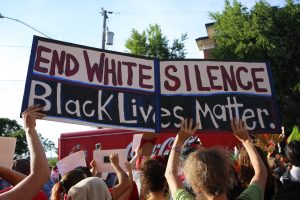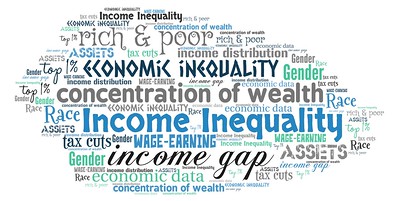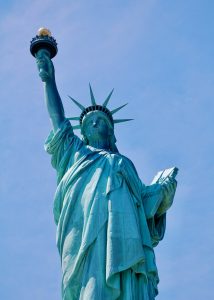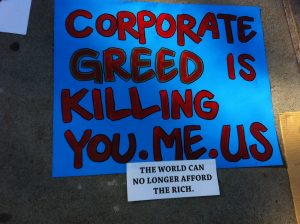1.10: Chapter 10- The Context of U. S. Government and Politics
- Page ID
- 73451
Troubled Race Relations

Try thinking of all the generic means by which one group of people can assault and dehumanize another group of people, and then consider that they have probably been done by some Americans to other Americans. We can start with the foundational sins: the near extermination of Native American peoples and 250 years of institutionalized slavery inflicted upon people abducted from Africa and their decedents. The mind reels at the challenge of adding up the stolen potential and the transferred wealth inherent in these sins. If we go beyond the foundational sins, the list of barbarisms is remarkable. Consider America’s many race riots in which Whites targeted Blacks, (3) or the number of violent uprisings caused by brutality and ill treatment of Blacks by police and local authorities. (4) Ponder the 120,000 Japanese Americans incarcerated in concentration camps during World War II. (5) Keep in mind the decades of lynchings that killed thousands of mostly African Americans and that served to “police” the behavior of all those who were not directly affected. (6) Think of church burnings, voter suppression, segregation, and militarized police violence that falls disproportionately on people of color. Consider America’s incarceration culture. Imagine a cross burned on your front lawn by an organization that for decades could freely march down the streets of any city in America without censure or repercussion.
The legacy of racial violence and ill will continues to reverberate through American society. It takes the form of disparities between Whites and Blacks on fundamental indicators such as income, wealth, educational attainment, and health. It also poisons our politics. In 2008, Barack Obama became the first African American president. For his entire presidency, he endured allegations that he wasn’t an American citizen and that he had allegiances to radical Islamic terrorists, which is a pretty good indication of how a portion of American society sees Blacks as illegitimate political actors. And while majorities of Whites and Blacks both acknowledge America’s troubled race relations, strong majorities of Blacks think that America has not gone far enough to ensure equal rights, while strong majorities of Whites think it has. (7) These feelings are remarkably resistant to change and may remain politically relevant long into the future, manifesting themselves in different ways in different contexts.
Crushing Inequality Marked by Attempts to Moderate It

Beginning in the 1960s and accelerating thereafter, Democrats and Republicans alike pursued policies designed to make the rich even more comfortable. Corporate tax rates and the marginal tax rates on wealthy individuals dropped like a stone. Most of the New Deal’s financial regulations were dropped in favor of deregulating financial institutions and the confusing “products” they developed, such as collateralized debt obligations. Ordinary Americans, in an attempt to maintain their lifestyle despite stagnant wages, job offshoring, less state support for education, and generally fewer economic opportunities, floated an increasing amount of debt: house mortgages with nothing down, student loans, credit cards, increasingly longer-term car loans, etc. In turn, this financialization of the economy made bankers and financiers even more wealthy. The 2008 Great Recession was the inevitable result. America’s political system responded—not by helping ordinary Americans—but by bailing out the bankers and the con artists who crashed the system with their irresponsibility. This is one of the most salient facts about the context of contemporary American politics, especially given that inequality has reached a new peak to rival the one that existed in the 1920s. The middle class in America has been hollowed out by wage stagnation, increased debt, and federal policies that benefit upper income families and corporations. The richest 1 percent of families in America possess more wealth than the entire middle class combined. (10)
Economic inequality is not simply a fact about the economy, for economic power translates into political power. Money buys legitimacy for ideas that otherwise would not be popular. Money pre-selects viable politicians before voters ever get a chance to weigh in. Money structures the media in ways so that some issues and policy options receive more coverage than do others. Money buys direct access to politicians and decision makers. As Lawrence Lessig once said, speaking of elected politicians, “A world where you have to spend half your time raising money means there’s this small number of people on whom you’re dependent and they have a huge influence.” (11)
America is an Immigrant Society that Often Vilifies Its Immigrants
The United States is an immigrant society. North and South America were initially settled by nomadic peoples who crossed from the Eurasian continent when sea levels were low during the last Ice Age. Following “discovery” by Europeans, North America was colonized by the British, French, Spanish, and other people from Western Europe. In 1619, they brought slaves to what later became Virginia, and probably earlier to Spanish Florida. In the nineteenth and twentieth centuries, the United States continued to attract immigrants, especially from Ireland, Germany, various places in eastern and southern Europe, China, and Japan. In the 1920s, the United States placed national origin quotas on immigration that benefited immigrants from northern and western Europe. These quotas were dropped in 1965. According to the Census Bureau, the number of foreign-born Americans peaked at 14.8 percent of the total population in 1890, dropped to a low of 4.7 percent in 1970, and reached a mini-peak of 12.9 percent in 2010.
Americans often pride themselves on their immigrant ancestors and on immigration’s role in American identity. We see ourselves defined by our common belief in American ideals of liberty, equality, and democracy rather than by our ethnicity or national origin. We see ourselves as a melting pot. Indeed, consider the Statue of Liberty, which features poet and immigrant-activist Emma Lazarus’ ode to America’s immigrants:

Corporate Personhood and Privilege

Corporations are artificial legal entities sanctioned by governments to accomplish specific economic tasks. Over the history of the American republic, corporations have come to be regarded by courts and the law as persons, and they have taken on many of the political rights once reserved only for human beings. Corporations even hijacked the Fourteenth Amendment’s language that “no state shall. . .deprive any person of life, liberty, or property without due process of law; nor deny to any person within its jurisdiction the equal protection of the laws.” That language was originally intended to protect actual people—particularly African Americans in the wake of slavery’s demise—from abuse by state authorities, but has since been used by conservatives and business lawyers to expand corporate rights. According to James Nelson, a retired Montana state supreme court justice, the idea “that corporations are constitutional persons is the Supreme Court’s bastard child that can never prove its legitimacy.” (13)
While corporations cannot cast ballots on election day, the list of corporate rights is breathtaking. Corporate charters are contracts that cannot be altered by governments. Corporations have due process and equal protection via the Fourteenth Amendment. Corporations have Fifth Amendment protections against being deprived of “life, liberty, or property, without due process of law,” just compensation for private property loss, and protection against double jeopardy. Corporations are covered by the Fourth Amendment’s protections against “unreasonable searches and seizures.” They have the right to jury trials in criminal and civil cases. Corporations have First Amendment freedom of speech protections for their commercial speech, and they can spend unlimited amounts of money advocating political causes and supporting candidates as an exercise of their freedom of speech. And private corporations have religious freedom protections, meaning they can limit employees’ privileges based on the corporation owner’s religious convictions. (14) And they have a megaphone like none other in American politics. Senator Sheldon Whitehouse described it this way: “Never in my life have I seen such a complex web of front groups sowing deliberate deceit to create public confusion about issues that should be clear. The corporate propaganda machinery is of unprecedented size and sophistication.” (15)
Not only are corporations considered people under the American political system, they are more vocal, more tenacious, longer lived, and possess better access to political decision makers than do ordinary individuals. This is an inherently corrosive situation for a democratic republic, because corporations are, by definition, amoral entities that pathologically pursue profit and growth with little heed for democracy. (16) Large corporations—and that’s really what we’re talking about here rather than mom and pop operations and other small businesses—have the resources and the persistence to shape public policies to create monopoly power, suppress wages, and put up barriers to competition. This fact, combined with the power of wealthy individuals, may be one of the main reasons why most ordinary people have little faith in the way democracy works in America. (17) For instance, economist Thomas Philippon wrote that “The real labor income of the typical worker has grown by less than one-third of 1 percent per year for nearly two decades. This explains in part why much of the middle-class distrusts politicians, believes the economic system is rigged, and even rejects capitalism altogether.” (18)
Conclusion
These, then, are the four contextual landmarks that help define the American political system. It is not anti-American or unpatriotic to acknowledge them. Think about this chapter in these terms: For individuals, a mark of maturity is the ability to acknowledge one’s mistakes, learn from them, and move forward. The contextual landmarks described here are mistakes that America has made and continues to make. They deeply affect the nature of our politics. Not only do they help us understand our political system, they are markers for whether we can become a mature political system that faces up to its past, learns from its mistakes, and moves forward in ways that improve the lives of ordinary Americans.
Acknowledging these mistakes does not lead us to specific policy recommendations. To see the current peak of inequality in America does not mean that we must advocate strict equality for everyone. We can accept that a certain amount of inequality may be healthy for a society, even if we reject the clearly unhealthy level of inequality now. Progressive policies to reduce inequality may very well be called for. To see the obvious legacies of slavery and the colonization of North America, as well as contemporary injustices, does not necessarily lead to the conclusion that formal reparations are required–although one might easily argue for them. However, past and present injustices do demand policies that promote social justice and truly equal opportunity that rewards merit and effort. A mature democracy can address difficult issues like these by using imagination and building consensus. An attenuated democracy cannot.
What if . . . ?
References and Notes
- Howard Zinn, “Introduction,” in Howard Zinn and Anthony Arnove, Voices of a People’s History of the United States. New York: Seven Stories Press, 2004. Page 28.
- That’s a heavy charge, but it’s probably the first thing space alien scientists would note about the United States. If you are doubtful, here’s a short reading list: Ibram X. Kendi, Stamped from the Beginning: The Definitive History of Racist Ideas in America. New York: Nation Books, 2016. Edward E. Baptist, The Half has Never Been Told: Slavery and the Making of American Capitalism. New York: Basic Books, 2014. Douglas A. Blackmon, Slavery by Another Name: The Re-Enslavement of Black Americans from the Civil War to World War II. New York: Anchor Books, 2009. Roxanne Dunbar-Ortiz, An Indigenous Peoples’ History of the United States. Boston: Beacon Press, 2014. David E. Stannard, American Holocaust: The Conquest of the New World. Oxford: Oxford University Press, 1992. Ronald Takaki, A Different Mirror: A History of Multicultural America. New York: Back Bay Books, 2008.
- A partial list of white-black conflict includes the New York City Draft Riots in 1863 and the racial turn they took; New Orleans in 1866; Wilmington in 1898; Atlanta in 1906; Omaha in 1919; Chicago in 1919; Tulsa in 1921.
- A partial list of riots and uprisings includes Detroit in 1967; Newark in 1967; Miami in 1980; Los Angeles in 1992; Cincinnati in 2001; Ferguson in 2014; Baltimore in 2015.
- Richard Reeves, Infamy: The Shocking Story of the Japanese Internment in World War II. New York: Henry Holt and Company, 2015. Lawson Fusao Inada, editor, Only What We Could Carry: The Japanese American Internment Experience. Berkley, CA: Heyday Books, 2000.
- Philip Dray, At the Hands of Persons Unknown: The Lynching of Black America. New York: Random House, 2002. Ralph Ginzburg, 100 Years of Lynchings. Baltimore: Black Classic Press, 1962.
- Juliana Menasce Horowitz, Anna Brown, and Kiana Cox, “Race in America 2019,” The Pew Research Center. April 9, 2019.
- Peter Lindert and Jeffrey Williamson, “Unequal Gains: American Growth and Inequality Since 1700,” CEPR Policy Portal. June 16, 2016.
- Gloria L. Main, “Inequality in Early America: The Evidence from Probate Records of Massachusetts and Maryland,” Journal of Interdisciplinary History. 7(4): Spring 1977. Pages 559-581.
- Anne Helen Petersen, “America’s Hollow Middle Class,” Vox. December 15, 2020. Dani Alexis Ryskamp, “The Life in The Simpsons is No Longer Attainable.” The Atlantic. December 29, 2020. Wealth figures come from the Federal Reserve, Distribution of Household Wealth in the U.S. Since 1989. Updated October 1, 2021.
- Quoted in Maggie Koerth-Baker, “Everyone Knows Money Influences Politics … Except Scientists,” fivethirtyeight.com.June 4, 2019.
- Philip Rucker, “Mitt Romney Says ‘Corporations are People’,” The Washington Post.August 11, 2011.
- The history of how corporations became vested with the political rights intended for natural persons (i.e., actual human beings) is too long and detailed to present here. See Adam Winkler, We the Corporations: How American Businesses Won Their Civil Rights. New York: Liveright Publishing Corporation, 2018. Jeffrey D. Clements, Corporations Are Not People: Why They Have More Rights Than You Do and What You Can Do About It. San Francisco: Berrett-Koehler Publishers, 2012. Doug Hammerstrom, The Hijacking of the Fourteenth Amendment. Published by ReclaimDemocracy.org. Adam Winkler “‘Corporations Are People’ is Built on an Incredible 19th Century Lie,” The Atlantic. March 5, 2018. James C. Nelson, “There’s No More Activist Court Than the US Supreme Court,” Counterpunch. February 3, 2022.
- Aside from the sources cited above, see also Jan Edwards, et al., Timeline of Personhood Rights and Powers created by Move to Amend. William Meyers, The Santa Clara Blues: Corporate Personhood Versus Democracy. III Publishing, 2000. Alex Park, “10 Supreme Court Rulings—Before Hobby Lobby—That Turned Corporations into People,” Mother Jones. July 10, 2014.
- Sheldon Whitehouse, Captured: The Corporate Infiltration of American Democracy. New York: The New Press, 2021. Page xviii.
- Joel Baken, The Corporation: The Pathological Pursuit of Profit and Power. New York: Free Press, 2004. Naomi Klein, The Shock Doctrine: The Rise of Disaster Capitalism. New York: Henry Holt and Company, 2007.
- David Kent, “The Countries Where People are Most Dissatisfied with how Democracy is Working,” The Pew Research Center. May 31, 2019.
- Thomas Philippon, “The U. S. Only Pretends to Have Free Markets,” The Atlantic. October 29, 2019.
Media Attributions
- BLM White Silence © Andy Witchger is licensed under a CC BY (Attribution) license
- 48612612772_8b98f1e883_w © Epictop10 is licensed under a CC BY (Attribution) license
- DSC_0065.JPG © David Hubert is licensed under a CC BY (Attribution) license
- Corporate Greed © a.mina is licensed under a CC BY (Attribution) license


